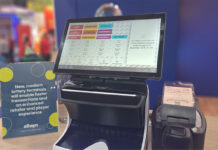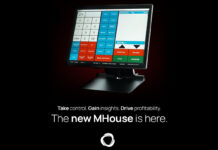
IS the digital revolution boosting or hampering local stores? Can wifi, social media, web-based commerce and more make a positive contribution to a retail outlet’s bottom line?

In this article she talks to retailers about their experience with digital communications.
In what the firm calls its ‘white paper’ – Crossing the Digital Divide, produced with research and insight company Him – it explores retailers’ understanding, use and resistance to digital tools.
“Access to the digital world used to be a barrier to the sector exploring this opportunity,” said Bryony Pemberton, insights and planning director at Cirkle.
“But with Ofcom reporting that 58% of the population now own a smartphone, and with the penetration of tablets in the convenience sector growing rapidly, there no longer is the same level of barriers restricting the uptake of digital tools.”
The report says 55% of retailers are actively using digital media in their businesses.
Online ordering, engaging with suppliers and visiting supplier websites were found to be the top three business uses for independent retailers. But there’s more that stores could do, especially in the fields of digital communication and social media, the report argues.
“Engaging with digital can help to highlight a store’s USP in the community, build customer relationships and awareness,” Pemberton said.
So how do typical Scottish local stores use digital resources and what has it done for them?
Tariq Ali, the owner of Calder stores in Coatbridge already uses some digital tools, and reckons others would be a benefit to his shop.
He already uses technologically advanced retail equipment and gives his customers access to wifi.
He’d like to install digital displays and has tried to in the past but has had problems purchasing them.
Tariq said: “A few companies have approached us about getting them but for some reason they didn’t go through with it.”
But he’s not keen on using social media, such as Facebook, to promote his shop.
“I haven’t heard any good things coming from it.”
Stephen Carr, owner of Nisa Local in Fleming Court, Stirling, thinks some digital methods can improve your business but he’s unsure about using digital displays as he feels they may distract consumers from the products around them.
The shop already has a Facebook page and although it hasn’t been used in a long time he will begin updating customers soon as he thinks it would benefit the store.
He said: “Using the site would mean that I will be able to communicate with customers and give them information quickly.”
Stephen thinks it’s a cheaper way to inform people about good deals and special offers as advertising can be quite expensive and flyers are “getting past their best”.
Colin MacDonald, owner of Costcutter in Blairgowrie was generally positive about using digital communications.
“Any form of enhancing your profile in the town or wherever your business is, is a good thing,” he suggested.
But he also recognises that any involvement would require a degree of work.
“I would like to set up a Facebook page for the shop but I would need some help, it may also take up too much time to run,” he said.
But he sees that there could be benefits in informing potential and regular customers about special deals.
He’s not so keen on providing wifi. The majority of his customers don’t need it, he reckons, and he also thinks it might encourage youths to hang about outside the shop, which could put older customers off visiting the store.

As for digital display screens, Colin said: “We have one for the Camelot lottery section, which I feel helps customers if they don’t know how to play.”
Ian Milne, owner of I & J General Stores in Aberdeen thinks using new methods in your shop is a good thing and “it keeps the shop looking up-to-date and fresh”.
Ian has digital displays in his store and thinks they do draw people’s attention to the products below, which encourages sales. He has a wifi connection, which is set up for both the lottery and the PayPoint terminal.
Natalie Greggain, owner of
Solo Convenience based in Baillieston, hasn’t had much luck when it comes to using digital displays, sees wifi as a no-go and is unsure about producing a social networking page for her shop.
“I had five digital advertising screens installed, which were linked to my epos system. However it was thoroughly unsuccessful as I had to lease the equipment under the premise I would receive advertising revenue from product companies advertising to cover the cost of the till.
“Nobody advertised except the National Lottery.”
The providing company liquidated and re-opened under a new name, which meant she was unable to take the issue to court, she said.
The shop doesn’t have a social networking page and Natalie reckons that as she isn’t offering customers unusual products there’s no need for it.
And she can see other downsides.
“I would be apprehensive of abuse being left for any customer refusals for alcohol etc. Although I should probably rethink this as I am probably worrying for no reason.”
She is however open to changing her mind about using the tool in the future.
“Maybe a social networking site could work for in-store use of online coupons,” she said.
Natalie has no plans to offer customers wifi because she doesn’t think customers spend enough time in the store to make use of it.
Robert Baillie, co-owner of Bailies in Perth, doesn’t have a Facebook page for his store but it does offer customers wifi access. And Robert thinks using digital tools is the right way to go.
He said: “I think it’s all going that way, I think newsagents will get left behind if they don’t use it.”
When asked whether he thought digital displays would benefit a convenience store he said: “We will certainly look at it, I think it helps at the till point and would encourage shoppers to impulse buy.”
Brian Millar, owner of News and Food in Bonnyrigg isn’t in a hurry to use many digital tools.
He doesn’t think installing digital displays would be worthwhile. “It’s just too small a shop and too expensive an investment,” he said.
But when it comes to setting up a social networking page, he has a different view: “It’s something we are considering getting within the next 12 months,” he said.

















